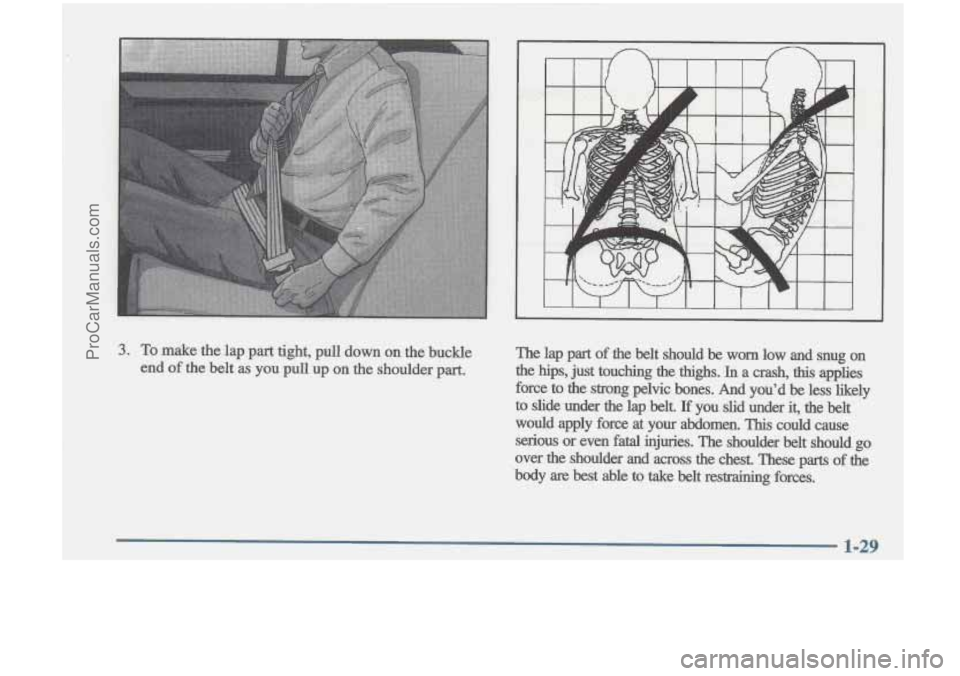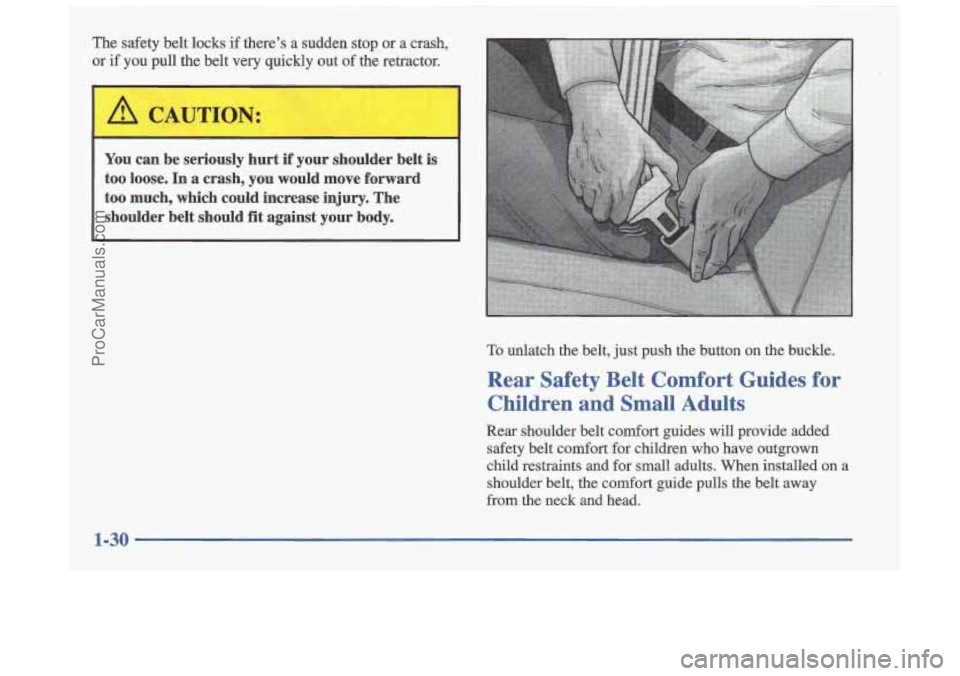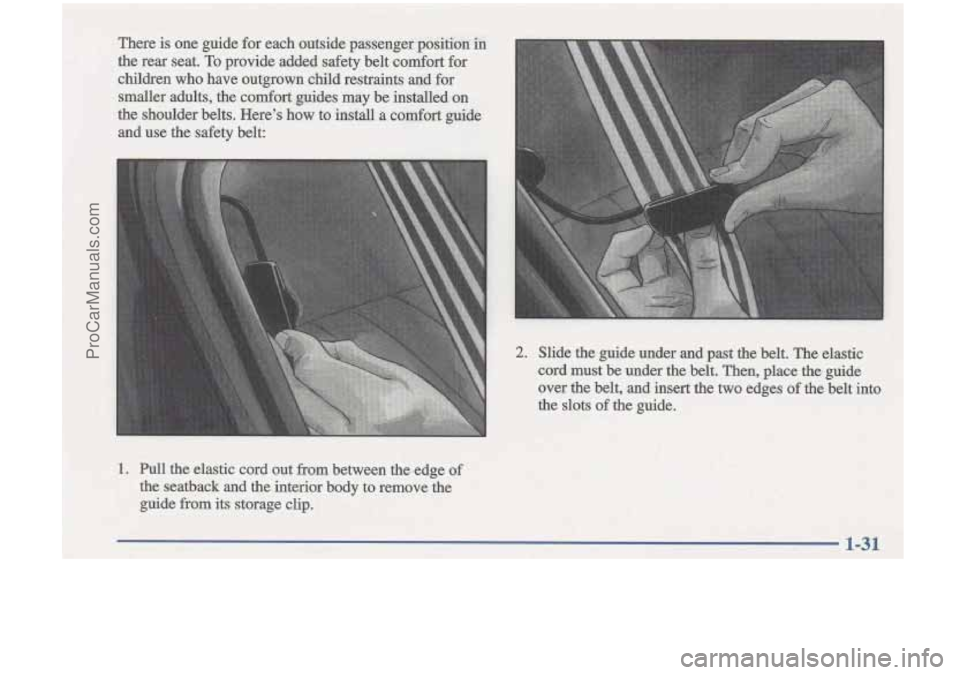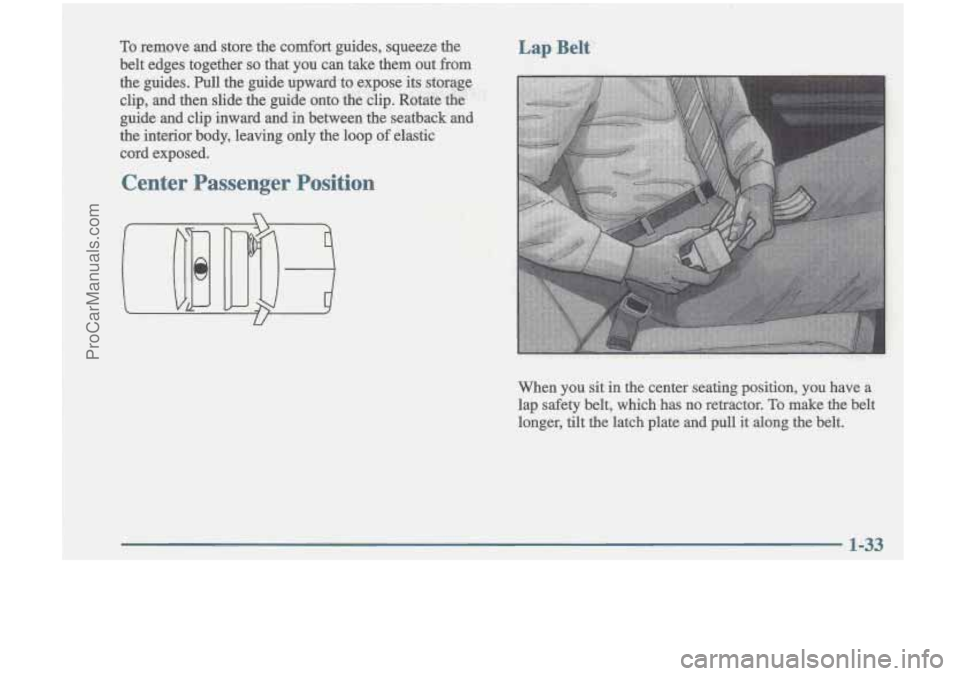OLDSMOBILE CUTLASS 1997 Owner's Guide
CUTLASS 1997
OLDSMOBILE
OLDSMOBILE
https://www.carmanualsonline.info/img/31/58202/w960_58202-0.png
OLDSMOBILE CUTLASS 1997 Owner's Guide
Trending: refrigerant type, lane assist, air conditioning, technical specifications, remote start, lock, center console
Page 31 of 353
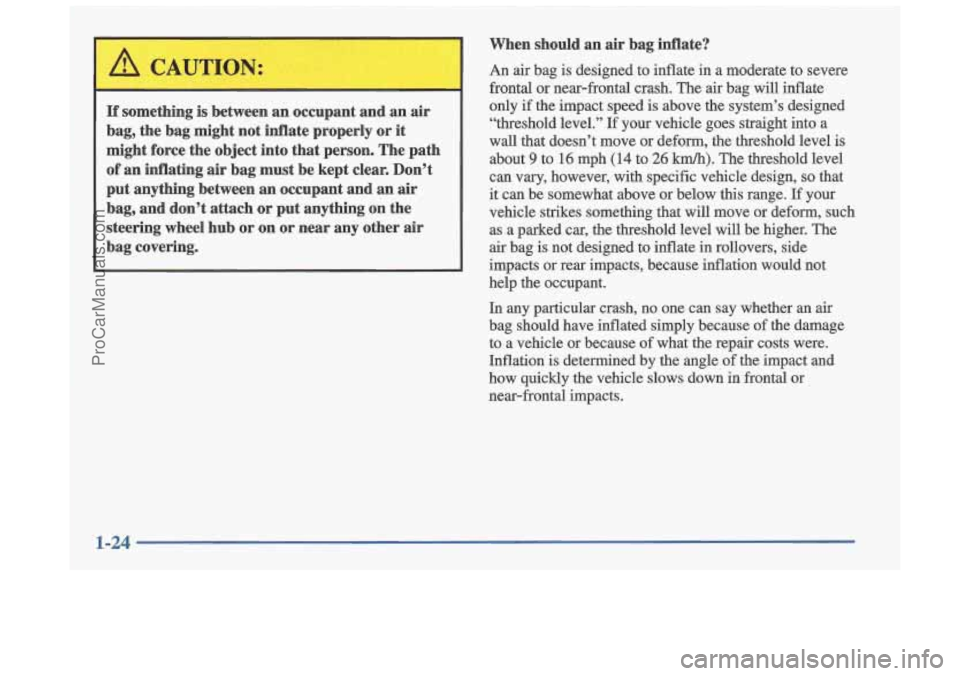
A
If something is between an occupant and an air
bag, the bag might not inflate properly or it
might force the object into that person. The path
of an inflating air bag must be kept clear. Don’t
put anything between an occupant and an air
bag, and don’t attach or put anything on the
steering wheel hub or on or near any other
air
bag covering. When should
an
air bag inflate?
An air bag is designed to inflate in a moderate to severe
frontal or near-frontal crash. The
air bag will inflate
only if the impact speed
is above the system’s designed
“threshold level.”
If your vehicle goes straight into a
wall that doesn’t move or deform, the threshold level is
about
9 to 16 mph (14 to 26 km/h). The threshold level
can vary, however,
with specific vehicle design, so that
it can be somewhat above or below this range.
If your
vehicle
strikes something that will move or deform, such
as a parked car, the threshold level will be higher. The
air bag is not designed to inflate in rollovers, side
impacts or rear impacts, because inflation would not help the occupant.
In any particular crash, no one can say whether an
air
bag should have inflated simply because of the damage
to a vehicle or because of what the repair costs were.
Inflation is determined by the angle of the impact and
how quickly the vehicle slows down in frontal or
near-frontal impacts.
1-24
ProCarManuals.com
Page 32 of 353
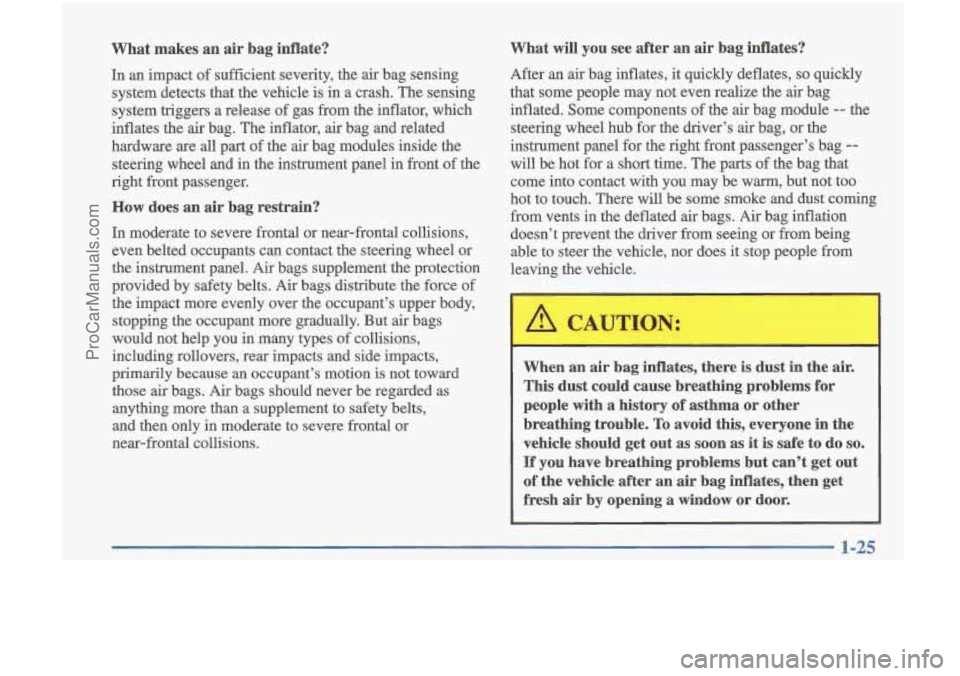
What makes an air bag inflate?
In an impact of sufficient severity, the air bag sensing
system detects that the vehicle is in a crash. The sensing
system triggers a release of gas from the inflator, which
inflates the air bag. The inflator,
air bag and related
hardware are all part of the air bag modules inside the
steering wheel and in the instrument panel in front of the
right front passenger.
How does an air bag restrain?
In moderate to severe frontal or near-frontal collisions,
even belted occupants can contact the steering wheel or
the instrument panel.
Air bags supplement the protection
provided by safety belts. Air bags distribute the force of
the impact more evenly over the occupant’s upper body, stopping the occupant more gradually. But air bags
would
not help you in many types of collisions,
including rollovers, rear impacts and side impacts,
primarily because
an occupant’s motion is not toward
those air bags.
Air bags should never be regarded as
anything more than a supplement to safety belts,
and then only in moderate to severe frontal or
near-frontal collisions.
What will you see after an air bag inflates?
After an air bag inflates, it quickly deflates, so quickly
that some people may not even realize the air bag
inflated. Some components of the air bag module
-- the
steering wheel hub for the driver’s air bag, or the
instrument panel for the right front passenger’s bag
--
will be hot for a short time. The parts of the bag that
come into contact with you may be warm, but not too
hot to touch. There will be some smoke and dust coming
from vents in the deflated air bags. Air bag inflation
doesn’t prevent the driver from seeing or from being
able to steer the vehicle, nor does it stop people from
leaving the vehicle.
When an air bag inflates, there is dust in the air.
This dust could cause breathing problems for
people with a history of asthma or other breathing trouble.
To avoid this, everyone in the
vehicle should get out as soon as
it is safe to do so.
If you have breathing problems but can’t get out of the vehicle after an air bag inflates, then get
fresh air by opening a window or
door.
1-25
ProCarManuals.com
Page 33 of 353
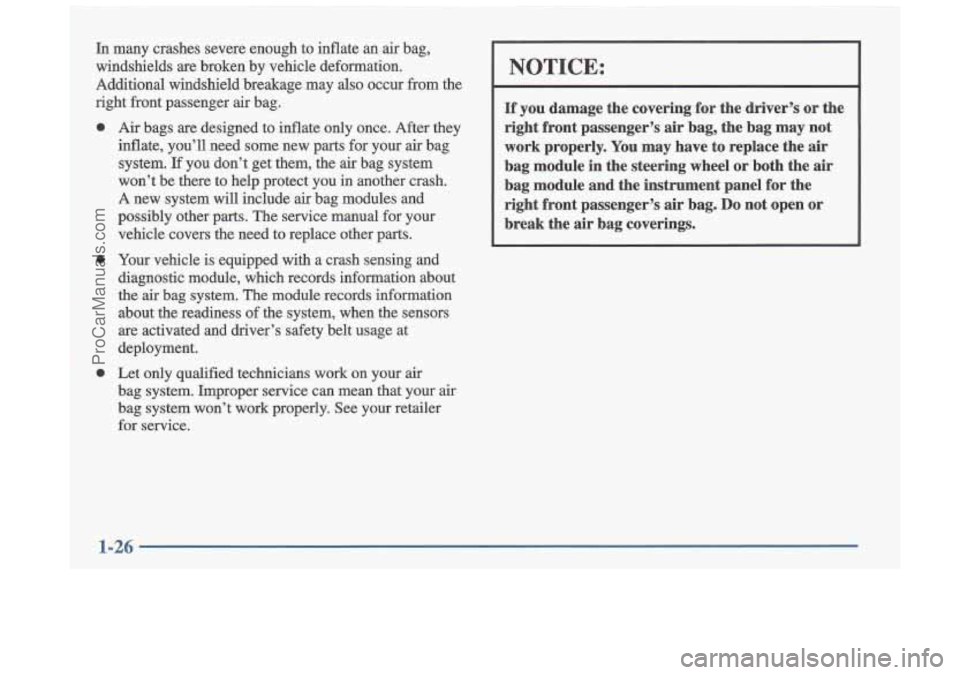
In many crashes severe enough to inflate an air bag,
windshields are broken by vehicle deformation.
Additional windshield breakage may also occur from the
right front passenger
air bag.
0
0
0
Air bags are designed to inflate only once. After they
inflate, you’ll need some new parts for
your air bag
system.
If you don’t get them, the air bag system
won’t be there to help protect you in another crash.
A new system will include air bag modules and
possibly other parts. The service manual for your
vehicle covers the need to replace other parts.
Your vehicle is equipped with a crash sensing and
diagnostic module, which records information about
the
air bag system. The module records information
about the readiness of the system, when the sensors
are activated and driver’s safety belt usage at
deployment.
Let only qualified technicians work on your
air
bag system. Improper service can mean that your air
bag system won’t work properly. See your retailer for service.
NOTICE:
If you damage the covering for the driver’s or the
right front passenger’s air
bag, the bag may not
work properly.
You may have to replace the air
bag module in the steering wheel or both the air
bag module and the instrument panel for the
right front passenger’s air bag.
Do not open or
break the
air bag coverings.
1-26
ProCarManuals.com
Page 34 of 353
Rear Seat Outside Passenger Positions
Lap-Shoulder Belt
The po8sitions next to the windows have lap-shoulder
belts. Here's how
to wear one properly.
1-27
ProCarManuals.com
Page 35 of 353
1. Pick up the latch plate and pull the'belt across you.
Don't let it get twisted.
The shoulder belt may lock if you pull the belt across
you very quickly. If this happens, let the belt go back
slightly to unlock it. Then pull the belt across you
more slowly.
2. Push the latch plate into the buckle until it clicks.
ProCarManuals.com
Page 36 of 353
Page 37 of 353
The safety belt locks if there's a sudden stop or a crash,
or
if you pull the belt very quickly out of the retractor.
ION:
You can be seriously hurt if your shoulder belt is
too loose.
In a crash, you would move forward
too much, which could increase injury. The
shoulder belt should
fit against your body.
To unlatch the belt, just push the button on the buckle.
Rear Safety Belt Comfort Guides for
Children and Small Adults
Rear shoulder belt comfort guides will provide added
safety belt comfort for children who have outgrown
child restraints and for small adults. When installed on
a
shoulder belt, the comfort guide pulls the belt away
from the neck and head.
1-30
ProCarManuals.com
Page 38 of 353
Page 39 of 353
Page 40 of 353
To remove and store the comfort guides, squeeze the
belt edges together
so that you can take them out from
3
ProCarManuals.com
Trending: gas type, warning, air conditioning, trailer, cruise control, oil filter, dimensions





